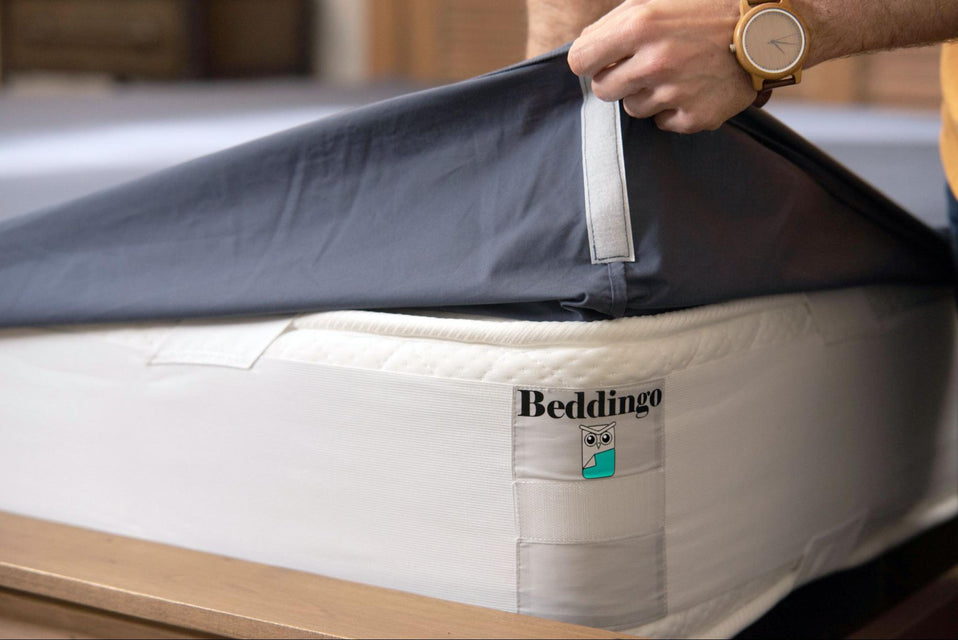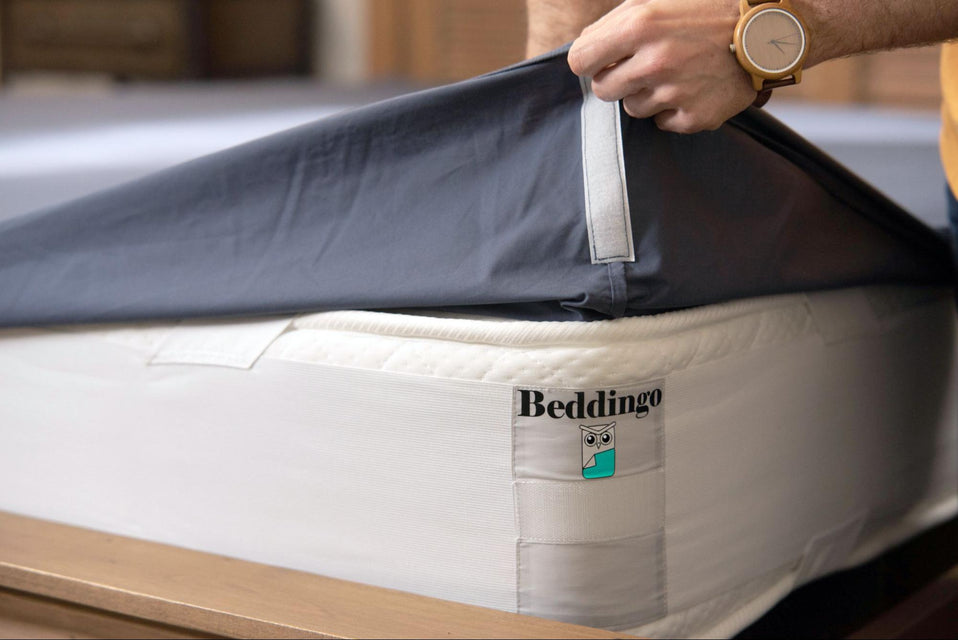Velcro bed sheets

The history of Velcro
The original hook-and-loop fastener was conceived in 1941 by Swiss engineer George de Mestral. The idea came to him one day after returning from a hunting trip with his dog in the Alps.
He took a close look at the burs of burdock that kept sticking to his clothes and his dog's fur. He examined them under a microscope and noted their hundreds of "hooks" that caught on anything with a loop, such as clothing, animal fur, or hair.
He saw the possibility of binding two materials reversibly in a simple fashion if he could figure out how to duplicate the hooks and loops. Hook-and-loop is regarded by some like Steven Vogel or Werner Nachtigall as a key example of inspiration from nature or the copying of nature's mechanisms (called bionics or biomimesis).

Brief about Velcro
Velcro has two parts – the hooks side and the loops side. The hooks part is rough whereas the part of the loop is soft. The loops part is basically composed of a thin mesh of loops. Other than not being damaged or damaged when washed in a washing machine, it also curls up and therefore becomes better with time.
Velcro is very resistant to water, heat, etc. It is used in both diving and space suits and even held together a human heart during the first artificial heart surgery.
Velcro lasts up to 20,000 cycles – in terms of the use in Beddingo Sheets, it means dozens of years (more long-lasting than any fabric).

Misconceptions
The first prototypes of Beddingo Sheets didn’t include any Velcro. We started with buttons, moved on to sorts of hooks, then tried Velcro, which was, and is a perfect match with bed sheets.
We thought about using Velcro for our ultimate fitted sheet right from the start, but avoided it because we had a few misconceptions about it:
We thought it wouldn’t do well in the laundry - which wasn’t true at all. We tested our Beddingo Sheets hundreds of times in total with no sign for decreasing in effectiveness is showing. It could start degrading eventually, but it would take so long, that the actual fabric of the bed sheet (any fabric) would be worn out long before.

We thought Velcro would make this disturbing Velcro noise at night - we designed the location and size of the Velcro in a way that there isn’t any noise. What we did was we made the hooks part - which could make the undesired noise - small and thin, so there isn’t much friction and rubbing between it and the fabric of Beddingo Base that in front of it.

We thought the hooks side of the Velcro might catch dust and dirt - The hooks side of Velcro stays clean and doesn’t catch dirt because it is fully covered by a bedsheet, and if you’re using mostly Beddingo Sheets, it also doesn’t pop off and the corners of the mattress are never exposed unintentionally.

We thought it wouldn’t hold the bed sheet in place - boy were we wrong. Velcro attachments are so strong, that we got the overlap area, between the hooks and the hoops parts, smaller and smaller, prototype after prototype, until we found that 1" stripe of the loops on Beddingo Sheet and 1.5" of the hooks side on Beddingo Base, results in strong enough grip but yet easy to detach.

The design
The Velcro on the corners is set vertically so the corners stay tight, but the Velcro on Beddingo Base is set horizontally, for easy attaching.
The loops side of the Velcro is sewn onto Beddingo Sheet, and it can be washed with any other items. The hooks side is sewn on Beddingo Base, which doesn’t require washing. If desired, there is no need to wash it more than once a year (low-heat program and separate from other laundry, washing instructions can be found on the label sewn onto the base).
To sum up, Velcro is a very durable material, that suits perfectly with fitted sheets - what we now call - Beddingo Sheets.







Leave a comment